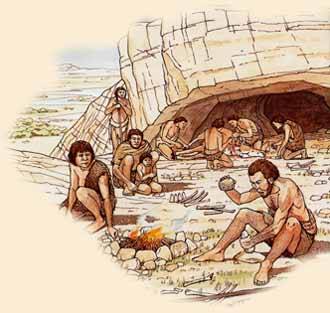#EnigmaticTraces
Explore tagged Tumblr posts
Text
The Paleolithic Era

Introduction: The Paleolithic: The Ancient Stone Age
Derived from the Greek words "palaiòs" (meaning "old") and "lìthos" (translating to "stone"), the Paleolithic represents the ancient era of stone. During this period, humans inhabited caves and sourced their food through hunting and gathering of wild plants, following a hunter-gatherer lifestyle.
The Art of Tools: From Flint to Amigdala
For tool-making, they used stones by chipping a piece of flint with harder stones. This method gave rise to choppers, which were used as weapons or for cutting meat and scraping hides.
Later on, these stones were chipped on both sides to create the amigdala, a kind of hand axe with an almond-like shape, sometimes decorated with geometric signs to emphasize ownership. This represents one of the first "artistic" expressions made by humans in this period.
Nomadic Dwellings: Caves and Prehistoric Shelters
Dwellings are not permanent since the hunter-gatherer lives in a nomadic manner. Consequently, Paleolithic humans tend to inhabit natural caves, such as those found in Pantalica, Sicily, but mainly in shelters resembling tent structures.
Artistic Expression: Birth of Rock Art
In the late Paleolithic, rock art emerged, with the first painted or engraved representations on rocks. These images depict animals and moving humans and seem to have had a dual function: they might have been used as part of propitiatory rituals to enhance hunting or as a narration of real events. Surprisingly, these representations maintain a remarkable degree of realism, though often stylized, allowing us to recognize the depicted animals even today.
Rock Treasures Worldwide: From Altamira to Val Camonica
Today, we can admire numerous examples of this artistic testimony in places like Altamira in Spain, Chauvet and Lascaux in France, Alt in Norway, the Tibesti Massif in Chad, Val Camonica in Lombardy, and Monte Pellegrino.
Hunters and Artists: Duality in Rock Images
Images of animals, as well as human figures, are the most recurring subjects of rock paintings. Their main function was probably of a magical and propitiatory nature: representing a hunting scene could bring luck to the hunters.
However, in scenes involving only animals, we might find a simple artistic purpose, that is, capturing, through drawing and color, the beauty of the surrounding reality.
Handprints: The First Form of Artistic Expression
The most primitive form of prehistoric painting comes to us in the form of handprints, obtained by pressing the color-soaked hand, tracing its outline with a finger dipped in pigment, or even spraying it with a straw. The use of these prints, often made with the left hand, remains shrouded in mystery, but undoubtedly, these enigmatic traces also speak the language of art.
Enigmas and Mysteries: Women behind the Prints
According to some scholars, a significant portion of the prints might belong to women, as the ring and index fingers of the hands that made them have the same length (while in men, on average, the ring finger is slightly longer).
The Allure of Ancient Traces: Prehistoric Art That Still Speaks
This detail adds a particular charm to these ancient prints, which remain a suggestive enigma in the history of prehistoric art.
#PaleolithicEra#AncientStoneAge#ToolMaking#RockArt#PrehistoricDwellings#NomadicLife#ArtisticExpression#RockPaintings#HistoricalTreasures#WorldHeritage#AncientArtifacts#PrehistoricCulture#ArchaeologicalWonders#CaveArt#PaleoArt#AncientMysteries#HumanEvolution#HistoricalDiscovery#EnigmaticTraces#PrehistoricCharm
0 notes